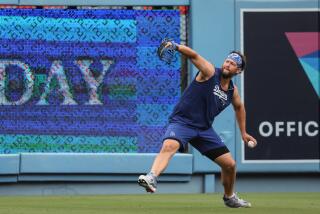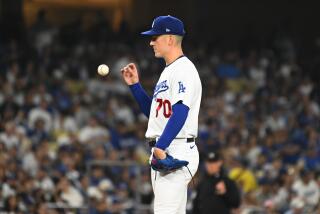Harkey Keeps Making His Best Pitch : Baseball: The former Cal State Fullerton star has overcome injuries to earn a spot in the Chicago Cubs’ rotation.
- Share via
SAN DIEGO — Signs of the old Mike Harkey, the one who dazzled baseball scouts during his days at Cal State Fullerton, the one who breezed through the Chicago Cubs’ minor league system as if he was the next Bob Gibson, are beginning to re-emerge.
His fastball is lighting up radar guns around the National League, as the San Diego Padres discovered in his most recent start. Harkey held the Padres hitless for seven innings in the Cubs’ 3-1 victory last Thursday.
Harkey is injury-free once again. There’s a smile on his face and more spring to his step. He’s fun to be around.
“He’s always laughing and he’s as loud as ever, just like he was in the minor leagues,” said Cub catcher Joe Girardi, who caught Harkey in double A and roomed with him for a month in triple A.
Just being part of a major league starting rotation for the first time would be reason enough for such giddiness from a 23-year-old rookie.
But there is a lot more to it in Harkey’s case. When you have been humbled as Harkey was in 1989--when your once-meteoric career takes a nose dive, bottoms out, and you bounce back and land in the major leagues, there is all the more reason to be chipper.
“I love it here in the big leagues,” said Harkey. “I want to be here all the time.”
Last year, Harkey wasn’t sure he would ever make it.
When the Cubs made Harkey their first-round pick--the fourth player chosen overall--in the 1987 June draft, they vowed not to rush him to the major leagues. But the way Harkey was pitching, there was no sense in holding him back.
Harkey made 12 starts at Class-A Peoria (Ill.) that summer, going 2-3 with a 3.55 earned-run average, and closed the season with an appearance at double-A Pittsfield (Mass.).
He split the 1988 season between Pittsfield, where he was 9-2 with a 1.37 ERA, and triple-A Iowa, where he was 7-2 with a 3.55 ERA. The Cubs called up Harkey in September and he made five starts, going 0-3 but impressing the club with a 2.60 ERA and his ability.
Cub Manager Don Zimmer told writers at the time that Harkey would be in his rotation come 1989.
“I made a bad statement,” Zimmer admitted.
Looking back, Zimmer said he might have put too much pressure on Harkey. But to pin Harkey’s 1989 calamity on Zimmer wouldn’t be fair. Harkey, a 6-foot-5, 220-pound right-hander, bears the blame.
Early in spring training, he developed tendinitis in his throwing shoulder, but he didn’t tell anyone.
“I tried to work it out by myself,” said Harkey, a 1984 graduate of Ganesha High School in Pomona. “I tried to throw through it, and that only made it worse.”
Harkey pitched poorly throughout spring training, and he lost some velocity on his fastball, normally clocked in the 90-m.p.h. range.
“That wasn’t the Harkey I knew,” Zimmer said. “I couldn’t take him to Chicago throwing 82 m.p.h.”
Late in spring training, Harkey confessed, telling his coaches about his shoulder problems. The organization sent him back to Iowa, where Harkey met more misfortune.
After three weeks on the disabled list, Harkey tried to come back, but was not at full strength. He was 2-7 with a 4.43 ERA in 12 starts.
Then, on June 25, Harkey tore cartilage in his right knee during a game at Syracuse. He underwent surgery on July 27 and missed the rest of the season.
For the first time in his baseball career, spanning high school, college and the pros, Harkey had flopped. And that didn’t sit too well with him.
“Everything went so smoothly for him the year before,” Girardi said. “He had to understand that being a major league player wasn’t success 100% of the time. You learn to go through periods where you struggle. I’m not sure he ever had to struggle before.”
Harkey doesn’t wince when he recalls 1989. “It only would have been painful if it had been a career-ending injury,” he said.
“I learned you can’t take anything for granted,” said Harkey, who is married and has an 18-month-old son. “In this game, anything can change in the blink of an eye. There are some people who think they have this game licked, and all of a sudden it turns on them. You have to be ready for anything, because anything can happen.”
Four months after his operation, Harkey was playing winter ball in Venezuela, where he pitched 50 innings in two months with no pain. He came to spring training in March with a healthy body and a sound mind.
“I was able to get my confidence back during winter ball,” Harkey said. “I found out I was completely healthy and ready to go. When I had my velocity from Day 1, I knew I could pitch in the big leagues.”
Harkey pitched well enough during the shortened spring to earn a spot on the major league roster and was projected as a long reliever. But when Rick Sutcliffe went on the 21-day disabled list with a shoulder injury, Zimmer inserted Harkey into the rotation.
In three starts, Harkey is 2-1 with a 2.60 ERA. He turned in his best performance Thursday, taking a no-hitter into the eighth inning before Phil Stephenson led off with a home run.
Zimmer then pulled Harkey in favor of Mitch Williams, who retired the Padres in the eighth and ninth innings to help the Cubs end a six-game losing streak.
“He’s still getting his feet on the ground, but I think you’ll see a big improvement in him by the All-Star break,” Zimmer said. “This is the first time he has ever been in a big league rotation, and we’re not looking for miracles. As the season goes, he’ll get better and better.”
Harkey isn’t expecting results overnight. Just as the Cubs appear to be showing patience with him--allowing him to live and learn on the major league level this season--Harkey has shown patience in himself.
“There will be days when I’ll walk a few and have lapses in concentration,” Harkey said. “But the ability to be a big-leaguer is being able to bounce back.”
More to Read
Go beyond the scoreboard
Get the latest on L.A.'s teams in the daily Sports Report newsletter.
You may occasionally receive promotional content from the Los Angeles Times.











